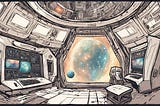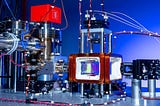Mar 6, 2025
16 stories
2 saves
Table of Contents:
01) Constructor Theory
02) Hume, Russel vs Popper Philosophy
03) Universal Constructor
04) Counterfactuals
05) Constructor theory of Information
06) DeWitt’s Totalitarian property
07) Information Media
08) Principles of Information Media
09) Superinformation Media
10) Non-classicality within Superinformation
11) Hybrid Quantum Systems
Table of Contents:
01) The QMware Cloud Service
02) Introducing Basiq SDK
03) Understanding QUBO Problems
04) Variational Quantum Algorithms (VQAs)
05) The General QUBO Problem
Table of Contents:
01) Quantum Mechanics and Hilbert Space Reconsidered
02) Ising Model: Quantum Mechanics’ Non-Foundational Role
03) Harmonic Oscillator: Quantum-Classical Link
04) Neutrino Sheets: Unique Quantum Perspective
05) Automata Models: Quantum Insights
06) Cellular Automaton
07) Cellular Automaton Interpretation
08) Ontological Basis: Bridging Quantum and Classical
Table of Contents:
01) Discovery of Individual Quantum Systems
02) Trapped Ion Quantum Computing: An Overview
03) Ion Trapping and Manipulation
04) Microstructure Traps
05) Laser Cooling and Motional Control
06) Qubit Realization and State Detection
07) Coherent Control and Quantum Gates
08) Single Qubit Gates and Laser Manipulation
09) Addressing Challenges and Technical Complexity
10) Quantum Manipulation of Atomic Magnetic Moments
11) Precision Individual Ion Addressing
12) Momentum Impartation via Microwave Radiation
13) MAGIC
14) Robust Two-Qubit Gates with Dynamic Decoupling
15) Gate Resilience against Motional Excitation
16) Advancing Quantum Algorithms through Multi-Qubit Gates
17) Efficient Implementation of the Toffoli Gate
18) Economic Quantum Computing with Half Adders
Table of Contents
01) Vortex Theory of Atoms
02) Nuanced Atomization through Vortex Rings
03) Peter Tait’s Knot Theory
04) Fundamentals of Knot Theory
05) The Significance of Knot Invariants
06) Exploration and Formulation of Kauffman Invariant
07) The Kauffman Invariant
08) Topological Equivalence
09) Complexities of Knot Invariants
10) Topological Quantum Field Theory
11) Topological Equivalence and Amplitudes in TQFT
12) Knot Invariants and Ed Witten’s Contributions
13) Proposed TQFT Computer
14) Flashback of Prehistory of Topological Quantum Computing
15) Topological Phases of Matter
16) Multiple Quasiparticles
17) Preparing Quasiparticle “Ket” and “Bra” States
18) Topological Phases of Matter Rules
19)Statistics and Non-Abelian Phenomena
20) Non-Abelian Statistics
21) Implications for Quantum Computation
22) Quantized Hall Effect
23) Exemplar Quantum Hall Sample
24) Fractional Quantum Hall Fluid
25) Topological Quantum Computation
26) Initialization and Measurement of States
27) Advantages
Table of Contents:
01) Quantum Computing Models
02) Quantum Computing Platforms
03) Photonic Quantum Computing — Two Approaches
04) Computation via Teleportation — The Fundamental Ingredient
05) The EPR State Generator: Squeezed Light Sources
06) Brief Overview of the Detection System: Homodyne Detector
07) Graphical Representation of EPR and Cluster States
08) Measurement-Based Quantum Computation
09) Cluster State Generation
10) 2D Cluster State Generation
11) Implementing Gates
12) Noise Addition and Error Correction
13) GKP Qubits
14) Bosonic Error Correction
15) Architecture and Fault-Tolerant Threshold
16) Challange: Generation of error-correctable state — GKP state
17) Pros of Photonic Quantum Computing
Table of Contents:
01) Electrons in Free Space
02) Electrons in Solids
03) Quantum Mechanics in Solids — Bloch’s Theory
04) Superconducting Materials
05) What are Quantum Materials?
06) Emergence
07) Spin Ice
08) Emergent Magnetic Monopoles
09) Experimental Confirmation of Monopoles
10) Magnetricity and Low Power Dissipation
11) Topological Electronic Materials
12) Skyrmions
13) Weyl Fermions
14) Weyl Semimetals
15) Magnetically induced Weyl semimetals
Table of Contents:
01) First two Decades of D-Wave
02) Phases of D-Wave Advancement
03) D-Wave’s Quantum Technology Milestones
04) D-Wave’s Advantage
05) D-Wave’s Hybrid Solvers: CQM and BQM
06) D-Wave’s Full Stack Quantum Computing Solution
07) D-Wave’s Three Verticals: Logistics, Pharma, and Finance
08) Quantum Annealing
09) Quantum Annealing-Different Perspective
10) Transverse Field Ising Hamiltonian
11) Quantum Annealing — Individual Qubit Level
12) RF SQUIDS
13) Tunable Qubit
14) Coupling Qubits
15) The Chip — Processor Layout
16) Quantum Annealing vs Gate-based Quantum Computing
17) Quantum Annealing vs QAOA
Table of Contents:
01) Introduction
02) Classical Silicon Nanoelectronics
03) Moore’s Law: Shrinking Transistors
04) From Bits to Qubits
05) Quantum Silicon Nanoelectronics
06) Challanges
07) Types of Silicon Spin Qubits
08) Current Status of Silicon Spin Qubits
09) Fabricating Quantum Dots
10) Fabricating donors in Silicon
11) Fabricate the Qubit
12) Control the spins
13) Readout the spins
14) Storing quantum information
15) Donor spin qubit coupling mechanisms
16) Coupling with a shared electron: Wavefunction sharing
17) Exchange-coupled donor electrons: 10nm — 20nm regime
18) Electric dipole-coupled flip-flop qubits
19) Scale-up inwards: Higher spin nuclei
20) Timed Implementation: Not scalable
21) Scale up outwards: Deterministic Implantation
22) Demonstrated Deterministic Implantation
23) Deterministically implanted donor qubits
24) Future hardware developments
25) Future Applications
26) Conclusion
Table of Contents:
01) Introduction
02) DiVincenzo Criteria for Superconducting Qubits
03) Harmonic Oscillators
04) Quantum Harmonic LC Oscillator
05) Superconducting Quantum Circuits
06) Nonlinear Superconducting Oscillators
07) Other types of Superconducting Qubits
08) Designing a Transmon Qubit
09) Tailoring Properties of a Transmon Qubit
10) Superconducting Qubit Readout
11) Implementing and Controlling Superconducting Qubits
12)Fabrication
13) Representing Qubits
14)Tunable Transmons
15) Finite Element Simulations
16) Single Qubit Gates
17) Two Qubit Gates
18) Control Hardware for Superconducting Quantum Computing
19) Control Software for Superconducting Quantum Computing
20) Conclusion
Table of contents:
01) Introduction
02) Practical Distribution of Useful Entanglement
03) Evolution of Quantum Communications
04) Qunnect’s Quantum Networking Products
05) Other Quantum Internet Companies
06) Challenges in Quantum Networking
07) Entanglement Distribution Networking
08) Next Steps: Entanglement Swapping & Teleportation
09) Conclusion
Table of Contents:
01) Introduction
02) 1. A scalable physical system with well characterized qubits
03) 2. The ability to initialize the state of the qubits to a simple fiducial state, such as |000⟩
04) 3. Long “relevant” decoherence times, much longer than the gate operation time
05) 4. A “universal” set of quantum gates
06) 5. A qubit-specific measurement capability
07) Additional Conditions
08) Conclusion
Table of Contents:
01) Introduction
02) Qubits Encoded in Atoms in Optical Tweezers
03) Magneto-Optical Trap (MOT)
04) Interactions Using the Rydberg States
06) Properties of the Rydberg States
07) Components in Detail
08) Recent Progress
09) Conclusion
Table of Contents:
01) Introduction
02) Exploring Alkaline-Earth Atoms
03) Two Key Aspects
04) Error Correction in Quantum Computing
05) Error Threshold
06) Fault-Tolerant Thresholds in Quantum Circuits
07) Enhancing Thresholds through Structured Noise
08) Erasure Errors: Error Localization
09) Implementing Erasure Errors in Neutral Atom Qubits
10) Metastable Yb: A Novel Neutral Atom Qubit
11) Metastable Qubit Overview
12) Preparing and Measuring 3p0 State
13) Metastable State Lifetime and Coherence
14) Converting 3p0 Decays into Erasures
15) Rydberg Gates on Nuclear Spin
16) Benchmarking with Random Circuit and Interleaved Benchmarking
17) Future Improvements and Generalizability






















